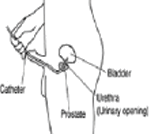Intermittent Self Dilatation for Male Urethral Stricture
Urethral dilatation & intermittent self dilatation
Urethral stricture dilatation is performed to keep the urethral passage open and prevent recurrence of a urethral stricture.

What is a urethral stricture?
A urethral stricture is an abnormal narrowing of the urethra. It can be caused by a build-up of scar tissue following infection, trauma or injury to the urethra. This narrowing may restrict the flow of urine, causing a poor urinary stream/flow, dribbling after the main flow has finished, needing to strain to pass urine, passing urine frequently and occasionally “spraying”.
Where are strictures commonly found in the urethra?
Men in particular, due to the length of the urethra may experience problems. Some potential problem areas are shown here:
What is urethral dilatation?
Usually, a stricture is treated by an operation to open the urethra called an `optical urethrotomy’, meatal or urethral dilatation. Following this procedure, the urologist will ask that you learn to perform intermittent self-dilatation on a regular basis to prevent the stricture reforming. Your healthcare professional will tell you how often you need to perform ISD. A size 16Ch to 18Ch single-use catheter is used.
Intermittent self-dilatation is performed by passing a hollow tube, called a catheter, into the urethra on a regular basis. The catheter is well lubricated so that it slides in easily. You can perform ISD over a long period of time and the catheter will not harm the delicate tissues of the urethra. Only use gentle pressure to insert the catheter, never force it. Continue to perform ISD until your healthcare professional tells you to stop.
Catheter Types
There are a number of different types of catheters available, all perform the same basic function. We are all individuals; you may find that one catheter suits you better than another. Your healthcare professional will advise you on the choice available and the one that best suits your needs.
Basic Hygiene
With intermittent self-dilatation it is essential that a clean procedure is used:
- Wash your hands (soap and water is fine, but an antibacterial hand gel can be used instead; this may be especially useful if you are away from home, using a public toilet etc).
- Wash your penis thoroughly. Mild soap and water is all that is required.
- Dry with a clean towel.
- Do not touch anything else apart from your catheter.
Performing intermittent self-dilatation
The information provided here is intended as follow-up advice to support the information already given to you. Always follow the advice given by the healthcare professional.
Insertion and Removal Procedure
- Ensure that you have followed the cleaning and washing routine.

- Lubricate the catheter following the manufacturer’s instructions.
- Pull back the foreskin (if you have one) and hold your penis up towards your tummy with one hand.
- Insert the catheter with the other hand, being careful not to touch the end that is to enter the bladder.

- If it is more difficult to insert as it gets nearer the bladder, cough slightly and continue to insert gently. If there is continued resistance withdraw and try again a little later.
- When the catheter reaches the bladder, ensure that the open end of the catheter is pointed towards the toilet, a bowl or jug as it will begin to drain urine immediately.
- Slowly withdraw the catheter and pull the foreskin forward.

- Dispose of the catheter.
- Look at the colour of your urine and note any change of colour or smell. This will indicate any problems with infection or if you are not drinking enough fluids.
- Wash your hands.
Questions and Answers
Handy hints for self-dilatation
Try to stay relaxed when inserting the catheter. If you feel tense, your sphincter muscle may tighten and make it difficult to insert or withdraw the catheter. Don’t force the catheter in or out. Coughing may help to relax your sphincter muscle.
If you have any difficulties inserting or removing your catheter, you should consult your healthcare professional.
Travel
Using self dilatation should not affect your ability to lead a normal life and that includes travel. You can fly and visit destinations at home and abroad just like anyone else. Below are some handy tips for you to consider when travelling.

Depending on the length of your journey, take enough catheters with you in your hand baggage. You should take some antibacterial gel or wipes when travelling to allow you to clean your hands, as not all toilets on your journey will have soap and running water.
Do not tightly coil your catheters as this can cause them to block. Some catheters can be loosely coiled for a short period, but this should be as short as possible. Follow your manufacturer’s recommendations.
Keep your catheters in a cool, dry place as excessive heat over a prolonged period may cause the lubricant to dry out.
Customs and Security officials may ask you questions about the catheters and other items you are carrying. Ask Fittleworth to send you a Travel Certificate that will help explain why you have the appliances with you.
Fittleworth can offer business or leisure travellers other forms of support too. Fittleworth is the exclusive UK member of the World Assist Alliance; a network dedicated to helping stoma and continence customers with emergency goods when abroad on holiday or business. The same discreet service you expect from Fittleworth and usually within 48 hours.
Who is eligible?
Fittleworth customers who have had 3 or more prescriptions dispensed in the previous 12 months. Simply call your normal Fittleworth contact number with your details and requirements and we will do the rest. There is no need to get a prescription or claim on insurance and World Assist Alliance is a FREE of charge service.
Please call us to check that your destination is covered under the World Assist Alliance programme.
